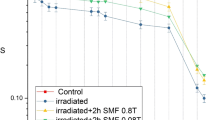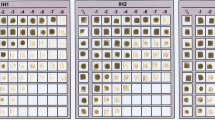Abstract
We report that the halophilic archaeon Halobacterium sp. strain NRC-1 is highly resistant to desiccation, high vacuum and 60Co gamma irradiation. Halobacterium sp. was able to repair extensive double strand DNA breaks (DSBs) in its genomic DNA, produced both by desiccation and by gamma irradiation, within hours of damage induction. We propose that resistance to high vacuum and 60Co gamma irradiation is a consequence of its adaptation to desiccating conditions. Gamma resistance in Halobacterium sp. was dependent on growth stage with cultures in earlier stages exhibiting higher resistance. Membrane pigments, specifically bacterioruberin, offered protection against cellular damages induced by high doses (5 kGy) of gamma irradiation. High-salt conditions were found to create a protective environment against gamma irradiation in vivo by comparing the amount of DSBs induced by ionizing radiation in the chromosomal DNA of Halobacterium sp. to that of the more radiation-sensitive Escherichia coli that grows in lower-salt conditions. No inducible response was observed after exposing Halobacterium sp. to a nonlethal dose (0.5 kGy) of gamma ray and subsequently exposing the cells to either a high dose (5 kGy) of gamma ray or desiccating conditions. We find that the hypersaline environment in which Halobacterium sp. flourishes is a fundamental factor for its resistance to desiccation, damaging radiation and high vacuum.







Similar content being viewed by others
Abbreviations
- DSBs:
-
Double-strand breaks
- ROS:
-
Reactive oxygen species
- EMS:
-
Ethyl methanesulfonate
- Gy:
-
Gray
References
Bala M, Jain V (1996) 2-DG induced modulation of chromosomal DNA profile, cell survival, mutagenesis and gene conversion in X-irradiated yeast. Indian J Exp Biol 34(1):18–26
Baliga NS, Bjork SJ, Bonneau R, Pan M, Iloanusi C, Kottemann MC, Hood L, DiRuggiero J (2004) Systems level insights into the stress response to UV radiation in the halophilic archaeon Halobacterium NRC −1. Genome Res 14(6):1025–1035 [Epub 2004 May 12]
Battista JR, Earl AM, Park MJ (1999) Why is Deinococcus radiodurans so resistant to ionizing radiation? Trends Microbiol 7:362–365
Billi D, Friedmann EI, Hofer KG, Caiola MG, Ocampo-Friedmann R (2000) Ionizing-radiation resistance in the desiccation-tolerant Cyanobacterium Chroococcidiopsis. Appl Environ Microbiol 66(4):1489–1492
Blaisdell JO, Wallace SS (2001) Abortive base-excision repair of radiation-induced clustered DNA lesions in Escherichia coli. PNAS USA 98(13):7426–7430
Carbonneau MA, Melin AM, Perromat A, Clerc M (1989) The action of free radicals on Deinococcus radiodurans carotenoids. Arch Biochem Biophys 275(1):244–251
Clavero MRS, Monk JD, Beuchat LR, Doyle MP, Brackett RE (1994) Inactivation of Escherichia coli 0157:H7, Salmonellae, and Campylobacter jejuni in raw ground beef by gamma irradiation. Appl Environ Microbiol 60(6):2069–2075
Constantinesco F, Forterre P, Koonin E, Aravind L, Elie C (2004) A bipolar DNA helicase gene, herA, clusters with rad50, mre11 and nurA genes in thermophilic archaea. Nucleic Acids Res 32:1439–1447
Crawford DR, Davies KJ (1994) Adaptive response and oxidative stress. Environ Health Perspect 102(Suppl)10:25–28
Daly MJ, Ouyang L, Fuchs P, Minton KW (1994) In vivo damage and recA-dependent repair of plasmid and chromosomal DNA in the radiation-resistant bacterium Deinococcus radiodurans. J Bacteriol 176(12):3508–3517
Daly MJ, Gaidamakova EK, Matrosova VY, Vasilenko A, Zhai M, Venkateswaran A, Hess M, Omelchenko MV, Kostandarithes HM, Makarova KS, Wackett LP, Fredrickson JK, Ghosal D (2004) Sep 30 Accumulation of Mn(II) in Deinococcus radiodurans facilitates gamma-radiation resistance. Science [Epub ahead of print]
Della M, Palmbos PL, Tseng H-M, Tonkin LM, Daley JM, Topper LM, Pitcher RS, Tomkinson AE, Wilson TE, Doherty AJ (2004) Mycobacterial Ku and ligase proteins constitute a two-component NHEJ repair machine. Science 360:683–685
Dianov GL, O’Neill P, Goodhead DT (2001) Securing genome stability by orchestrating DNA repair: removal of radiation-induced clustered lesions in DNA. BioEssays 23:745–749
DiRuggiero J, Santangelo N, Nackerdien Z, Ravel J, Robb FT (1997) Repair of extensive ionizing-radiation DNA damage at 95°C in the hyperthermophilic archaeon Pyrococcus furiosus. J Bacteriol 179:4643–4645
DiRuggiero J, Brown JR, Bogert AP, Robb FT (1999) DNA repair systems in Archaea: mementos from the last universal common ancestor? J Mol Evol 49:474–484
Fish SA, Shepherd TJ, McGenity TJ, Grant WD (2002) Recovery of 16S ribosomal RNA gene fragments from ancient halite. Nature 417(6887):432–436
Gerard E, Jolivet E, Prieur D, Forterre P (2001) DNA protection mechanisms are not involved in the radioresistance of the hyperthermophilic archaea Pyrococcus abyssi and P. furiosus. Mol Genet Genomics 266(1):72–78
van Gerwen SJ, Rombouts FM, van’t Riet K, Zwietering MH (1999) A data analysis of the irradiation parameter D10 for bacteria and spores under various conditions. J Food Prot 62(9):1024–1032
Gruber C, Legat A, Pfaffenhuemer M, Radax C, Weidler G, Hans-Jürgen B Helga S-L (2004) Halobacterium noricense sp. nov., an archaeal isolate from a bore core of an alpine Permian salt deposit, classification of Halobacterium sp. NRC-1 as a strain of H. salinarum and emended description of H. salinarum. Extremophiles [E-pub 30 July 2004]
Gutman PD, Carroll JD, Masters CI, Minton KW (1994) Sequencing, targeted mutagenesis and expression of a recA gene required for the extreme radioresistance of Deinococcus radiodurans. Gene 141:31–37
Holden JF, Baross JA (1993) Enhanced thermotolerance and temperature-induced changes in protein composition in the hyperthermophilic archaeon ES4. J Bacteriol 175:2839–2843
Hopfner KP, Karcher A, Shin D, Fairley C, Tainer JA, Carney JP (2000) Mre11 and Rad50 from Pyrococcus furiosus: cloning and biochemical characterization reveal an evolutionarily conserved multiprotein machine. J Bacteriol 182(21):6036–6041
Hubmacher D, Matzanke BF, Anemuller S (2002) Investigations of iron uptake in Halobacterium salinarum. Biochem Soc Trans 4:710–712
Jolivet E, L’Haridon S, Corre E, Forterre P, Prieur D (2003) Thermococcus gammatolerans sp. nov., a hyperthermophilic archaeon from a deep-sea hydrothermal vent that resists ionizing radiation. Int J Syst Evol Microbiol 53(3):847–851
Jolivet E, Corre E, L’Haridon S, Forterre P, Prieur D (2004) Thermococcus marinus sp. nov. and Thermococcus radiotolerans sp. nov., two hyperthermophilic archaea from deep-sea hydrothermal vents that resist ionizing radiation. Extremophiles 8(3):219–227. [Epub 2004 Feb 27]
Keller LC, Maxcy RB (1984) Effect of physiological age on radiation resistance of some bacteria that are highly radiation resistant. Appl Environ Microbiol 47(5):915-918
Koike J, Oshima T, Koike KA, Taguchi H, Tanaka R, Nishimura K, Miyaji M (1992) Survival rates of some terrestrial microorganisms under high conditions. Adv Space Res 12(4):271–274
Komori K, Miyata T, DiRuggiero J, Holley-Shanks R, Hayashi I, Cann IK, Mayanagi K, Shinagawa H, Ishino Y (2000a) Both RadA and RadB are involved in homologous recombination in Pyrococcus furiosus. J Biol Chem 275(43):33782–33790
Komori K, Sakae S, Fujikane R, Morikawa K, Shinagawa H, Ishino Y (2000b) Biochemical characterization of the Hjc Holliday junction resolvase of Pyrococcus furiosus. Nucleic Acids Res 28(22):4544–4551
Lanyi JK (1974) Salt-dependent properties of proteins from extremely halophilic bacteria. Bacteriol. Rev 38:272–290
Makarova KS, Aravind L, Wolf YI, Tatusov RL, Minton KW, Koonin EV, Daly MJ (2001) Genome of the extremely radiation-resistant bacterium Deinococcus radiodurans viewed from the perspective of comparative genomics. Microbiol Mol Biol Rev 65(1):44–79
Mancinelli RL, White MR, Rothschild LJ (1998) Biopan-survival I: Exposure of the Osmophiles Synechococcus Sp. (Nageli) and Haloarcula Sp. to the space environment. Adv Space Res 22:327
Marguet E, Forterre P (1998) Protection of DNA by salts against thermodegradation at temperatures typical for hyperthermophiles. Extremophiles 2(2):115–122
Martin EL, Reinhardt RL, Baum LL, Becker MR, Shaffer JJ, Kokjohn TA (2000) The effects of ultraviolet radiation on the moderate halophile Halomonas elongata and the extreme halophile Halobacterium salinarum. Can J Microbiol 46(2):180–187
Mattimore V, Battista JR (1996) Radioresistance of Deinococcus radiodurans: functions necessary to survive ionizing radiation are also necessary to survive prolonged desiccation. J Bacteriol 178(3):633–637
McCready S (1996) The repair of ultraviolet light-induced DNA damage in the halophilic archaebacteria, Halobacterium cutirubrum, Halobacterium halobium and Haloferax volcanii. Mutat Res 364(1):25–32
McGenity TJ, Gemmell RT, Grant WD, Stan-Lotter H (2000) Origins of halophilic microorganisms in ancient salt deposits. Environ Microbiol 2(3):243–50
Minton KW, Daly MJ (1995) A model for repair of radiation-induced DNA double-strand breaks in the extreme radiophile Deinococcus radiodurans. BioEssays 17(5):457–464
Moseley BEB (1983) Photobiology and radiobiology of Micrococcus (Deinococcus) radiodurans. Photochem Photobiol Rev 7:223–275
Ng WL, Yang CF, Halladay JT, Arora P, DasSarma S (1995) Protocol 25: isolation of genomic and plasmid DNAs from Halobacterium halobium. In: Robb FT, Place AR, Sowers KR, Schreier HJ, DasSarma S, Fleischmann EM (eds) Archaea: a laboratory manual. Cold Spring Harbor Laboratory Press, Newyork pp 179–180
Ng WV, Kennedy SP, Mahairas GG, Berquist B, Pan M, Shukla HD, Lasky SR, Baliga N, Thorsson V, Sbrogna J, Swartzell S, Weir D, Gall J, Dahl TA, Welti R, Goo YA, Leithauser B, Keller K, Cruz R, Danson MJ, Hough DW, Maddocks DG, Jablonski PE, Krebs MP, Angevine CM, Dale H, Isenbarger TA, Peck RF, Pohlschrod M, Spudich JL, Jung KH, Alam M, Freitas T, Hou S, Daniels CJ, Dennis PP, Omar AD, Ebhardt H, Lowe TM, Liang P, Riley M, Hood L, DasSarma S (1997) Genome sequence of Halobacterium species NRC-1. PNAS USA 22:12176–12181
Nicholson WL, Munakata N, Horneck G, Melosh HJ, Setlow P (2000) Resistance of Bacillus endospores to extreme terrestrial and extraterrestrial environments. Microbiol Mol Biol Rev 64(3):548–572
Peck RF, DasSarma S, Krebs MP (2000) Homologous gene knockout in the archaeon Halobacterium salinarium with ura3 as a counterselectable marker. Mol Micro 35(3):667–676
Potts M (1994) Desiccation tolerance of Prokaryotes. Microbiol Rev 58(4):755–805
Rieder R, Gellert R, Anderson RC, Bruckner J, Clark BC, Dreibus G, Economou T, Klingelhofer G, Lugmair GW, Ming DW, Squyres SW, d’Uston C, Wanke H, Yen A, Zipfel J (2004) Chemistry of rocks and soils at Meridiani Planum from the alpha particle X-ray spectrometer. Science 306(5702):1746–1749
Riley PA (1994) Free radicals in biology: oxidative stress and the effects of ionizing radiation. Int J Radiat Biol 65(1):27–33
Saffary R, Nandakumar R, Spencer D, Robb FT, Davila JM, Swartz M, Ofman L, Thomas RJ, DiRuggiero J (2002) Microbial survival of space vacuum and extreme ultraviolet irradiation: strain isolation and analysis during a rocket flight. FEMS Microbiol Lett 215(1):163–168
Salin MN, Brown-Peterson NJ (1993) Dealing with active oxygen intermediates: a halophilic perspective. Experientia 49:523-529
Shahmohammadi HR, Asgarani E, Terato H, Saito T, Ohyama Y, Gekko K, Yamamoto O, Ide H (1998) Protective roles of bacterioruberin and intracellular KCL resistance of Halobacterium salinarium against DNA-damaging agents. J Radiat Res 39:251–262
Trent JD, Gabrielsen M, Jensen B, Neuhard J, Olsen J (1994) Acquired thermotolerance and heat shock proteins in thermophiles from the three phylogenetic domains. J Bacteriol 176:6148–6152
Ulsh BA, Miller SM, Mallory FF, Mitchel RE, Morrison DP, Boreham DR (2004) Cytogenetic dose–response and adaptive response in cells of ungulate species exposed to ionizing radiation. J Environ Radioact 74(1–3):73–81
Vreeland RH, Rosenzweig WD (2002) The question of uniqueness of ancient bacteria. J Ind Microbiol Biotechnol 28(1):32–41
Acknowledgements
This work was supported by grants from NASA (#NCC9147), and the HFSP (#RG522002). We would like to thank Vince Adams for his technical assistance irradiating the cells and Marvin Swartz for high vacuum exposure.
Author information
Authors and Affiliations
Corresponding author
Additional information
Communicated by W.D. Grant
Rights and permissions
About this article
Cite this article
Kottemann, M., Kish, A., Iloanusi, C. et al. Physiological responses of the halophilic archaeon Halobacterium sp. strain NRC1 to desiccation and gamma irradiation. Extremophiles 9, 219–227 (2005). https://doi.org/10.1007/s00792-005-0437-4
Received:
Accepted:
Published:
Issue Date:
DOI: https://doi.org/10.1007/s00792-005-0437-4




